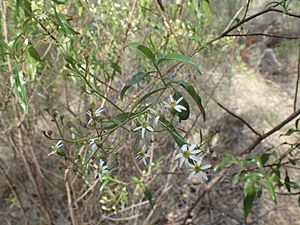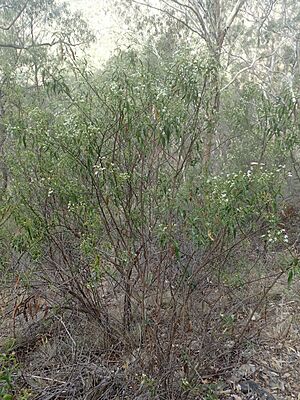Sticky daisy bush facts for kids
Quick facts for kids Sticky daisy bush |
|
|---|---|
 |
|
| Olearia elliptica flowers in the Oxley Wild Rivers National Park | |
| Scientific classification |
The Olearia elliptica, also known as the sticky daisy bush, is a type of shrub. It belongs to the daisy family, called Asteraceae. This plant grows naturally in New South Wales and Queensland in eastern Australia. It has leaves that feel sticky and white flowers that bloom in summer and autumn.
Contents
What the Sticky Daisy Bush Looks Like
The sticky daisy bush is a shrub that usually grows to be about 2 meters (about 6.5 feet) tall. Its leaves are scattered along the stems. They are curved and shaped like an ellipse, which is like a stretched circle. These leaves are usually 20 to 115 millimeters (about 0.8 to 4.5 inches) long and 5 to 38 millimeters (about 0.2 to 1.5 inches) wide. Each leaf has a short stalk up to 12 millimeters long.
The top side of the leaves feels sticky. The bottom side is a lighter green color. The flowers grow in clusters at the ends of the stems. Each flower cluster is 11 to 26 millimeters (about 0.4 to 1 inch) wide. These clusters grow on a flower stalk up to 12 millimeters long.
Each "flower" you see is actually made of many tiny flowers. It has between 8 and 23 white, petal-like parts called ray florets. In the center, there are 8 to 30 tiny yellow flowers called disc florets. The sticky daisy bush blooms between November and May. After flowering, it produces small, bristly, dry fruits called achenes.
Naming the Sticky Daisy Bush
The scientific name for this plant, Olearia elliptica, was first officially described in 1836. A scientist named Augustin Pyramus de Candolle wrote about it in his large 17-volume book about plants.
The second part of its scientific name, elliptica, is a Latin word. It means "a defective circle" or "an ellipse." This name refers to the shape of the plant's leaves.
In 1993, another scientist named Peter Shaw Green found that there were two slightly different types of O. elliptica. These types are called subspecies. The Australian Plant Census, which is an official list of Australian plants, accepts both of these:
- Olearia elliptica subsp. elliptica: This type has more flower clusters, usually between 20 and 50. It grows in New South Wales and Queensland.
- praetermissa: This type is a smaller plant. It has fewer flowers in its clusters, usually between 8 and 15. This subspecies is only found on Lord Howe Island. The name praetermissa is a Latin word meaning "overlooked." This refers to the fact that this distinct type was only recently recognized.
Where the Sticky Daisy Bush Grows
The subspecies elliptica grows in Australia. You can find it from Berry in the south, all the way north along central and eastern New South Wales to the Queensland border. It prefers areas that get more than 900 millimeters (about 35 inches) of rain each year. It is common in the Sydney Basin area.
Growing Sticky Daisy Bush in Gardens
The sticky daisy bush is a good plant for gardens. It grows well in different conditions. It prefers soils that are a bit acidic, and it can grow in places that get some shade or full sun.


